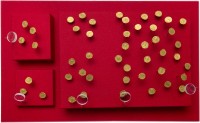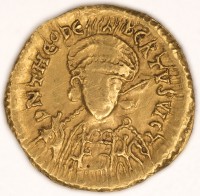 Two metal detector enthusiasts searching in the Netherlands’ northeastern Drenthe province have discovered 47 gold coins from late antiquity and the early Middle Ages. The treasure consists of gold solidi minted in Constantinople, Rome, Ravenna and Laon, in northern France. Most of the coins, 38 of them, are Byzantine and depict the emperor Justinian. The most recent coin dates to 541 A.D. It’s rare to find loose gold coins from this period in the northern Netherlands; a coin hoard is unique. The last time gold treasure was unearthed in Drenthe was 1955.
Two metal detector enthusiasts searching in the Netherlands’ northeastern Drenthe province have discovered 47 gold coins from late antiquity and the early Middle Ages. The treasure consists of gold solidi minted in Constantinople, Rome, Ravenna and Laon, in northern France. Most of the coins, 38 of them, are Byzantine and depict the emperor Justinian. The most recent coin dates to 541 A.D. It’s rare to find loose gold coins from this period in the northern Netherlands; a coin hoard is unique. The last time gold treasure was unearthed in Drenthe was 1955.
The gold solidi each weigh more than four grams for a total of more than 200 grams, making the find the greatest amount of 6th century currency by weight ever found in the Netherlands. One coin is the only example of its kind discovered on Dutch soil. It’s a Frankish coin minted by the Merovingian King Theudebert (534-548), the first king to issue characteristic Merovingian coinage bearing his own image rather than the Byzantine emperor’s.
To prevent treasure hunters flocking to the site, no information is being divulged about the exact find area. We thus don’t know much about the context, but whoever buried the coins is likely to have been a high ranking personage in the local ruling elite.
That there was such a huge amount of money in circulation, according to an archaeologist involved means that Drenthe was an important political factor. […]
The money may have been a diplomatic payment, probably a pay-off to keep the Drenthe people away from the boundaries of the Merovingian kingdom. That kingdom then was from the South of France to the major rivers in the [central] Netherlands.
 Very little is known about the Netherlands of the 6th century and few archaeological remains from the period have been unearthed, so this find would be nationally significant even if it weren’t a flashy stash of gold solidi.
Very little is known about the Netherlands of the 6th century and few archaeological remains from the period have been unearthed, so this find would be nationally significant even if it weren’t a flashy stash of gold solidi.
The discovery was made this spring, and the finders reported it promptly to the province’s government archaeologists. The find was announced to the public on Friday. The treasure was acquired by the Drenthe Museum which put the coins on public display starting Saturday. The hoard now takes its place as one of the most important exhibitions in the museum. Museum director Annabelle Birnie, as quoted in the Drenthe province’s press release:
“We are very pleased with our newest addition. It’s a great addition, and of great importance to our archaeological collection. In addition to the gold treasure of Tomahawk from the 5th century and the coin treasure Nietap from the 7th century, we now have a masterpiece in the 6th century, a period about which relatively little is known. This acquisition, combined with further research can give us new insights into this period of the Early Middle Ages.”